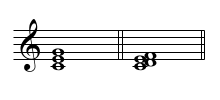Chords
Once you understand intervals, we can move onto learning chords. If you don't know intervals, I have written several articles on them so be sure to check them out before your start learning chords.
Chords are any 3 or more notes that are played simultaneously. Notes like C-E-G or C-D-E-F would be considered a chord when played together. As long as there are more than 3 notes being played at the same time. you can call that a chord.

Triads
There is one particular type of chords that we should study and understand above all. That is called 'triads'. A triad is a collection of 3 notes stacked in the interval of 3rds on top of each other. Chords like C-E-G, and F-A-C are triads, and these triads are called "C major triad" and "F major triad" respectively. The order of the notes can be rearranged. It is a triad as long as the 3 notes can be stacked in 3rds.

Triads are chords, so we often say "C major chord" instead of "C major triad". One important thing you should know here is that while triads are always chords, chords are not always triads. As I mentioned before, chords are any 3 or more notes played simultaneously. Triads are a specific kind of chords. In other words, the word 'chords' and 'triads' are not always interchangeable.
To show you an example of how chords are not always triads, take a look at the chords below. First of all, one of the chords is made up of 4 notes. Secondly, either of the chords, we cannot stack them in 3rds no matter how we rearrange them. They are chords, but not triads.

Why we should study chords
Nearly every piece is built upon scales and chords. By understanding chords you will:
- 1.) play more in tune because you can fit notes you are playing in relation to the chord that you hear.
- 2.) understand chord progressions and chord structure of a piece.
- 3.) understand why certain chords sound pretty while others are ugly or scary.
- 4.) understand music from the composers' perspective.
- 5.) have fun dissecting a piece of music to see how it was composed.
All in all, you will start to think of music from a new perspective, which will open your eyes to more possibilities when you interpret a piece of music.
Next, we are going to learn about the major, minor, diminished, and augmented triads.